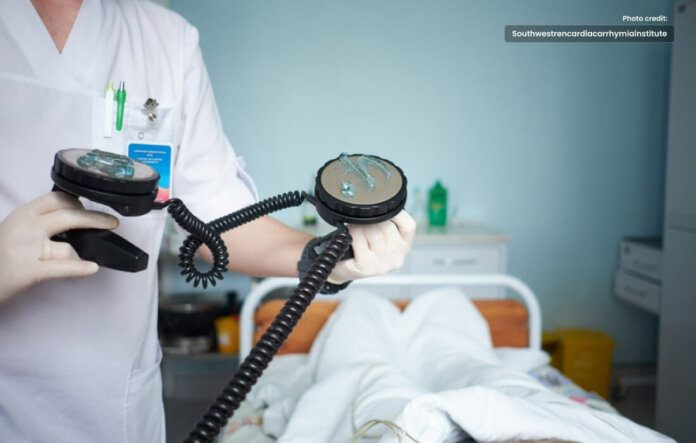Cardioversion restores normal heart rhythm in specific arrhythmias.
Introduction
The human heart is a magnificent organ, tirelessly pumping blood to sustain life. However, sometimes this essential rhythm can be disrupter by irregular heartbeats, known as arrhythmias. These disturbances in the heart’s electrical activity can lead to serious consequences, compromising blood flow and overall well-being. Thankfully, modern medical advancements offer an effective solution to restore the heart’s natural rhythm: cardioversion.
What is Cardioversion?
Cardioversion is a medical procedure use to correct abnormal heart rhythms, particularly atrial fibrillation (AFib) or atrial flutter. In these conditions, the atria, the upper chambers of the heart, contract irregularly and out of sync with the lower chambers, the ventricles. As a result, blood is not efficiently pump, potentially leading to complications such as stroke or heart failure.
The goal of cardioversion is to synchronize the heart’s rhythm back to normal through the use of electrical or chemical interventions. By doing so, it can alleviate symptoms, improve the heart’s efficiency, and reduce the risk of associate complications.
Types of Cardioversion
There are two primary methods of cardioversion:
-
Electrical Cardioversion:
In electrical cardioversion, a control electrical shock is deliver to the heart externally through paddles or patches place on the chest. This shock briefly interrupts the abnormal electrical signals and allows the heart’s natural pacemaker to reestablish a regular rhythm.
The procedure is usually perform under sedation or general anesthesia to minimize discomfort for the patient. It is essential to monitor the patient’s heart rhythm and vital signs carefully during and after the procedure.
-
Pharmacological Cardioversion:
Pharmacological cardioversion involves using medications, such as antiarrhythmic drugs, to restore the heart’s regular rhythm. These drugs work by modifying the electrical signals in the heart and can be administer orally or intravenously.
The choice between electrical and pharmacological cardioversion depends on various factors, including the type and duration of the arrhythmia, the patient’s overall health, and their response to previous treatments.
Preparing for Cardioversion
Before undergoing cardioversion, a thorough evaluation is essential to ensure the procedure is safe and appropriate for the patient. The evaluation may include:
-
Medical History and Physical Examination:
The healthcare provider will review the patient’s medical history and perform a physical examination to assess their overall health and identify any potential risk factors.
-
Electrocardiogram (ECG or EKG):
This painless test records the heart’s electrical activity and helps diagnose the type of arrhythmia.
-
Blood Tests:
Blood tests are conduct to check for any underlying conditions or medications that may affect the procedure.
-
Medication Review:
The patient’s current medications will be review to avoid potential interactions with the cardioversion procedure.
-
Fasting:
The patient may be require to fast for a few hours before the procedure, especially if it is scheduled under general anesthesia.
The Cardioversion Procedure
On the day of the cardioversion, the patient will be prep for the procedure, which may include the placement of an intravenous (IV) line for administering medications. In the case of electrical cardioversion, sedation or general anesthesia will be administere to ensure the patient remains comfortable.
For electrical cardioversion, the defibrillator is set to deliver the appropriate level of electrical shock to the heart. The shock is carefully time to coincide with a specific point in the cardiac cycle to increase its effectiveness.
Recovery and Follow-up
After cardioversion, the patient will be monitored closely in a recovery area. It is normal to feel some drowsiness and mild discomfort after the procedure. Depending on the patient’s condition, they may need to stay in the hospital for observation for a short period.
Once the patient is stable, they will receive instructions on post-procedure care, which may include:
- Medications: Antiarrhythmic medications or blood thinners may be prescribed to maintain the heart’s regular rhythm and reduce the risk of blood clots.
- Lifestyle Changes: Adopting a heart-healthy lifestyle with a balanced diet, regular exercise, and stress management can help prevent future episodes of arrhythmias.
- Follow-up Appointments: Regular follow-up appointments with the healthcare provider will be scheduled to monitor the heart’s rhythm and adjust treatment as needed.
Conclusion
By electrically or pharmacologically resetting the heart’s rhythm, it can significantly improve a patient’s quality of life and reduce the risk of serious complications. However, it is essential to undergo a thorough evaluation and receive proper medical guidance to determine the most suitable approach for each individual. With modern medical advancements and expert care, cardioversion continues to offer hope and healing to those affected by irregular heartbeats, allowing them to enjoy life’s precious moments with a revitalized heart.
Always remember to consult a qualified healthcare professional for personalized advice and recommendations regarding your health.




